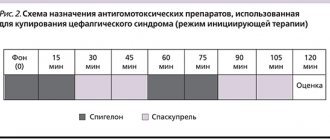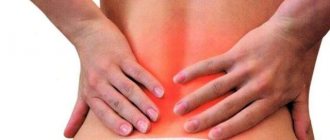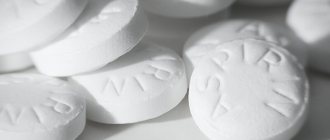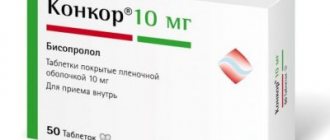Pharmacodynamics and pharmacokinetics
This is a combined drug that has a vasodilator, analgesic and analgesic effect. A good antispasmodic, which determines the use of Andipal for blood pressure.
Metamizole sodium, which is part of the composition, reduces body temperature and relieves pain. Once in the gastrointestinal tract, the substance is well and quickly absorbed and blocks the prostaglandin system of arachidonic acid, increasing the sensitivity threshold of pain centers in the hypothalamus .
Papaverine hydrochloride dilates blood vessels (reduces the level of calcium in cells) located on the periphery and significantly reduces the overall tone of the smooth muscles of the surface of internal organs.
Bendazole is an antispasmodic, dilates blood vessels, stimulates the spinal cord, and restores nerve endings in the periphery.
Phenobarbital exhibits its sedative properties and enhances the effects of other components of the drug.
Mechanism of action of the drug
Andipal has established itself as an effective antispasmodic, quickly normalizing blood pressure and relieving symptoms associated with hypertension: severe headache, feeling of heat, tachycardia, nervous agitation.
- Analgin slows down the release of prostaglandins of the arachidonic group, reduces pain, and affects the activity of the body's thermoregulation center.
- Papaverine slows down the flow of calcium into cells, reduces vascular tone, relaxes smooth muscle fibers, eliminating peripheral spasms. Helps improve blood supply to internal organs and reduce headaches.
- Bendazole complements the action of papaverine, dilates the vascular bed, improves the functions of the spinal cord, eliminates the feeling of body numbness, dizziness and other neurological symptoms.
- Phenobarbital reduces nervous excitement, reduces sensitivity to stress factors, calms, and helps eliminate insomnia.
The active substances used together reduce the symptoms of disorders of the heart, blood vessels, central nervous system, and internal organs.
The tablets quickly dissolve under the action of gastric juice and are absorbed into the blood. The effect of the drug develops within 15–30 minutes and lasts up to 8–10 hours. The substances do not accumulate in the body; they are transformed in the liver. Metabolites are excreted with intestinal contents and through the kidneys.
Indications for use of Andipal. What does it help with?
Andipal tablets, what are they for?
- Indications for the use of the drug are migraines of various types.
- Pain associated with spasms of cerebral vessels in the head.
- The medicine helps against pain caused by spasms of smooth muscles or internal organs of the gastrointestinal tract.
- For mild forms of hypertension, it can be used as blood pressure pills.
What blood pressure should I take the medicine for? For primary or secondary hypertension, Andipal can be taken for high blood pressure.
Who should use Andipal?
The drug is prescribed for pain caused or accompanied by vascular spasms, increased blood pressure:
- for migraines: mild to moderate;
- tension headaches;
- symptoms of weather dependence;
- pain and spasms in the area of the gallbladder, liver, pancreas, intestines associated with impaired vascular tone or spasms of the muscles of internal organs;
- for pain in the pelvic organs;
- for high blood pressure: in complex therapy of primary and secondary hypertension at the initial stage.
During the period of use of the medicine, the total amount of NSAIDs and antispasmodics used together with Andipal should be taken into account in order to avoid an overdose.
Contraindications
- Acute increased sensitivity to the constituent substances of the drug (especially pyrazolone).
- For glucose-6-phosphate dehydrogenase deficiency, various blood diseases, porphyria.
- Severe dysfunction of the kidneys and liver, tachyarrhythmia , angina pectoris, intestinal obstruction .
The use of the drug is contraindicated for children under 8 years of age during lactation.
Vasodilator drugs prescribed for osteochondrosis
The work of the muscles of the vascular highways is constantly regulated by nerve impulses passing through sympathetic fibers. These signals are responsible for the muscular activity of almost all internal organs and related functions.
Eliminating stagnation of blood fluid and improving microcirculation in the pathological area makes it possible to normalize metabolic processes and restore the patency of nerve impulses, as a result of which the treatment of osteochondrosis is more effective and the patient’s health condition is stabilized.
Features of the pathogenesis of osteochondrosis disease
Nowadays, osteochondrosis disease (age-related degenerative changes in intervertebral discs) is quite common among the population. This is due to a sedentary lifestyle or, on the contrary, excessively hard physical labor, back injuries, bad habits, poor diet and inadequate sleep.
Initially, the symptoms of osteochondrosis manifest themselves as minor discomfort in the back after physical activity, limited mobility, then pain syndromes become more intense and become chronic. Destructive processes in the intervertebral discs (dehydration and insufficient supply of nutrients) provoke inflammation and swelling of the pathological area (decreased blood circulation in it). The body’s protective reaction to irritation becomes even greater muscle stiffness and pain.
Soft tissue spasms compress sympathetic nerve endings and fibers, the transmission of impulses weakens, the muscle walls of blood vessels do not receive the necessary information and also find themselves in a compressed state. Poor circulation over time leads to oxygen starvation (hypoxia).
Complex conservative treatment of the spine, as a rule, includes taking vasodilating drugs. Results of action of pharmacological agents of the vasodilator group:
- normalization of blood circulation in the pathological area and throughout the body;
- improving the nutrition of soft tissues, saturating them with fluid, accelerating metabolic processes;
- reduction of inflammation and swelling of tissues, congestion and, consequently, pain;
- restoration of the passage of nerve impulses through the fibers.
Mechanisms of drug action
The group of vasodilator drugs used to treat osteochondrosis of the joints is conventionally divided into subgroups:
- substances with myotropic effects that directly affect the muscles of the vascular walls, changing their metabolic processes and reducing tone (caffeine, papaverine, no-spa);
- drugs with neurotropic effects achieve a vasodilating effect through nervous regulation of the tone of blood vessels;
- centrally acting drugs that affect the functioning of the vasomotor center located in the brain (aminazine, apessin);
- peripheral substances:
- blocking vascular adrenergic receptors (phentolamine);
- blocking the transmission of impulses (excitation) from the nerve endings of the sympathetic branches innervating the corresponding blood lines (ornid, octadin);
- improving the transmission of impulses from parasympathetic endings to blood vessels (acetylcholine, carbacholine);
- complicating the transmission of impulses in sympathetic nerve clusters, thereby reducing vascular tone (pentamine, tetamone);
- drugs with a mixed mechanism of action - central neurotropic and peripheral myotropic (nitroglycerin, amyl nitrite, reserpine, the latter weakens the sensitivity of central and peripheral adrenergic receptors responsible for the innervation of blood vessels, expands their lumen, and also lowers blood pressure).
List of main drugs prescribed for osteochondrosis
Actovegin. It has not so much vasodilating properties as stimulating tissue regeneration. It contains many nutrients: amino acids, saccharides, nucleosides. It has a positive effect on the transport, absorption and utilization of glucose and oxygen molecules, and stabilizes the plasma membranes of cells. Restores blood flow in peripheral systems, normalizes and stimulates nutrient metabolism throughout the body, develops and regenerates collaterals (small branches of blood vessels formed during compression or thrombosis of the main channel).
Eufillin. A bronchodilator, it helps relax the muscles of the bronchi, relieves spasms, dilates blood vessels, which makes it indispensable for patients suffering from asthma. Significantly improves blood circulation in the brain and peripheral vessels, and is used to treat diseases of the spine and neurological pathologies. Stimulates the action of the respiratory centers, increases the frequency and intensity of heart contractions, which makes it unsafe for patients with acute heart failure, angina pectoris and cardiac arrhythmias. Can be used for external use in the form of electrophoresis to improve blood microcirculation in pathological areas and restore trophic processes in intervertebral discs.
Pentoxifylline or trental. Improves microcirculation and regenerating properties of blood, thins the blood, reduces total peripheral vascular resistance, dilates the coronary arteries, which accelerates the transport of oxygen throughout the body. By expanding the blood vessels of the lungs, it significantly increases the tone of the muscle fibers responsible for breathing (diaphragm and intercostal muscles). Strengthens collateral blood circulation, increases the concentration of ATP in the brain, and has a beneficial effect on the bioelectrical functions of the central nervous system. The drug is contraindicated in patients with chronically low blood pressure, atherosclerosis and arrhythmia.
Xanthinol nicotinate. Improves cerebral circulation, peripheral (collateral) microcirculation, reduces the manifestations of cerebral hypoxia (insufficient oxygen supply to the brain), normalizes and improves metabolic (metabolic) processes in the brain. Thins the blood and has a beneficial effect on the functioning of the heart.
Thioctic acid, lipoic acid or berlithion. The drug is from a group of vitamin-like substances, similar to those produced by the body, and is close in biochemical properties to vitamin B group. Participates in the regulation of lipid (fat) and carbohydrate metabolism, prevents the deposition of glucose on the walls of blood vessels, improves blood flow and lowers blood viscosity. It has detoxifying properties and has a positive effect on the functions of peripheral nerves and neurovascular bundles innervating internal organs.
Medicines prescribed for cervical osteochondrosis
Symptoms of cervical osteochondrosis primarily affect the blood supply to the brain, the condition of the vertebral arteries, the vertebrobasilar circle, and then can affect the vessels and nerve endings innervating the upper limbs. They are manifested by dizziness, headaches, nausea, coordination disorders, general weakness and fatigue, disturbances in the functioning of the organs of hearing, vision, speech, and smell.
Treatment of cervical osteochondrosis quite often includes nootropic drugs (for example, piracetam, nootropil, vinpocetine), which improve blood circulation in the vessels of the head and improve metabolic processes (carbohydrate and protein) in the brain. They do not always have pronounced vasodilating properties, but they have a beneficial effect on the central nervous system, improve memory, attention, and increase productivity.
Piracetam. It has a positive effect on metabolic reactions in the body, improves blood circulation in the brain, and restores nerve cells. The drug increases energy potential through accelerated ATP metabolism, has a beneficial effect on the central nervous system and is prescribed for diseases of the blood vessels that wash the cerebral cortex.
Vinpocetine. A vasodilator, antihypoxic agent, helps to increase cerebral circulation, especially in ischemic areas by relaxing the smooth muscles of the walls of cerebral vessels. Improves oxygen transport, reduces platelet aggregation and thereby thins blood viscosity.
It is necessary to treat osteochondrosis with complex measures: medications (which, as prescribed by a doctor, may include vasodilators), physiotherapy and physical activity.
The main thing is not to endure the pain, not to delay time, but to contact osteochondrosis treatment clinics in a timely manner. Author: K.M.N., Academician of the Russian Academy of Medical Sciences M.A. Bobyr
Side effects
According to the annotation: constipation , nausea , various allergic reactions ( conjunctivitis , urticaria, Quincke's edema ), nephritis , red urine , drowsiness , increased sweating .
With long-term use, agranulocytosis , leukopenia , and thrombocytopenia .
Before use, you should consult your doctor.
Andipal
The frequency of these side effects is indicated in accordance with the WHO classification: very often - more than 10%; often - more than 1% and less than 10%; infrequently - more than 0.1% and less than 1%; rarely - more than 0.01% and less than 0.1%; very rarely - less than 0.01%, including isolated cases: frequency unknown - based on available data, it was not possible to establish the frequency of occurrence.
For Andipal:
To date, no side effects have been reported with this combination. The incidence of the following possible side effects is unknown.
From the central nervous system
: drowsiness, decreased speed of psychomotor reactions.
From the digestive system
: nausea, constipation.
From the cardiovascular system
: arterial hypotension.
Allergic reactions
:
With long-term use
: leukopenia, agranulocytosis, impaired liver and kidney function.
For Metamizole sodium:
From the skin
: uncommon - persistent drug rash; rarely - rash (for example, maculopapular); very rarely - Stevens-Johnson syndrome, toxic epidermal necrolysis.
From the urinary system
: very rarely - acute renal dysfunction, which in very rare cases can lead to proteinuria, oligo- or anuria and acute renal failure, acute interstitial nephritis.
From the hematopoietic organs
: rarely - leukopenia; very rarely - agranulocytosis, including fatal cases, thrombocytopenia; frequency unknown - aplastic anemia, pancytopenia, including fatal cases.*
*These reactions can occur even if metamizole sodium has not previously caused complications. There are a number of signs of an increased risk of agranulocytosis if metamizole sodium is used for more than one week. This reaction is dose-independent and can occur at any time during treatment. It is manifested by high fever, chills, sore throat, pain when swallowing, inflammation of the mucous membranes of the mouth, nose, throat, genital and anal area. However, when antibiotics are used, these phenomena may be mild. There is a slight enlargement of the lymph nodes and spleen or no enlargement at all. The erythrocyte sedimentation rate increases significantly, the content of granulocytes is sharply reduced or they are not detected. As a rule, but not always, normal levels of hemoglobin, red blood cells and platelets are maintained. Treatment tactics involve immediate discontinuation of the drug, i.e. the drug should be discontinued immediately, without waiting for laboratory results, if there is an unexpected deterioration in the general condition, the fever does not subside, or new or painful ulcerations appear on the mucous membranes, especially in the mouth, nose or throat. If pancytopenia occurs, the drug should be discontinued immediately and a complete blood count should be monitored until its values return to normal.
From the cardiovascular system
: uncommon - isolated decrease in blood pressure (possibly pharmacologically caused and not accompanied by other manifestations of anaphylactic/anaphylactoid reactions). The decrease in blood pressure can be pronounced. During fever, a dose-dependent sharp decrease in blood pressure without other signs of a hypersensitivity reaction is also possible.
Allergic reactions
: rarely - anaphylactoid or anaphylactic reactions; ** very rarely - analgesic bronchial asthma. In patients with analgesic bronchial asthma, intolerance usually manifests itself as attacks of bronchial asthma; frequency unknown - anaphylactic shock. **
**These reactions are especially common with parenteral administration of metamizole sodium and can be severe and life-threatening, in some cases leading to death. These reactions can occur even if metamizole sodium has not previously caused complications. These reactions may occur during administration or immediately after ingestion, or develop several hours later. However, they predominantly occur within the first hour after application. In milder cases, they manifest as rashes on the skin and mucous membranes (eg, itching, burning, redness, blistering and swelling), shortness of breath and, less commonly, gastrointestinal disorders. In severe cases, these mild reactions can develop into generalized urticaria, severe angioedema (including of the larynx), severe bronchospasm, cardiac arrhythmia, arterial hypotension (in some cases preceded by an increase in blood pressure), shock. In this regard, at the first signs of skin reactions, the drug should be discontinued.
Others
: Not known - Red urine has been reported and may be due to the presence of low concentrations of rubazonic acid (a metabolite of metamizole sodium).
For Phenobarbital:
From the central nervous system
: frequency unknown - asthenia, dizziness, general weakness, ataxia, nystagmus, paradoxical reaction (especially in elderly and weakened patients - agitation), hallucinations, depression, nightmares, syncope.
From the digestive system
: frequency unknown - vomiting, liver dysfunction with long-term use.
From the hematopoietic organs
: frequency unknown - agranulocytosis, megaloblastic anemia, thrombocytopenia.
Allergic reactions
: frequency unknown - skin rash, urticaria, swelling of the eyelids, face and lips, difficulty breathing, rarely - exfoliative dermatitis, malignant exudative erythema (Stevens-Johnson syndrome).
Others
: frequency unknown - with long-term use drug dependence.
For Bendazole:
The listed effects appear when used in large doses. When the dose is reduced or the drug is discontinued, these side effects quickly disappear.
From the central nervous system
: frequency unknown - dizziness, headache.
From the skin:
frequency unknown - increased sweating.
From the digestive system
: frequency unknown - nausea.
For Papaverine hydrochloride:
From the central nervous system
: often - drowsiness.
From the skin
: often - skin rash (usually erythematous, urticaria), infrequently - itching, rarely - increased sweating.
From the digestive system
: often - nausea, constipation, infrequently - increased activity of liver transaminases.
From the cardiovascular system:
often - decreased blood pressure, infrequently - ventricular extrasystole.
From the hematopoietic organs
: very rarely - eosinophilia.
Instructions for use of Andipal (Method and dosage)
How to use the drug? Inside. Adults should take 1-2 tablets 2-3 times a day. The full course of treatment should take 7-10 days.
Before taking the medicine, consult your doctor. The course of treatment should be prescribed by a specialist, depending on the nature of the disease and its course. It is not recommended to take the drug for more than 10 days.
How to take if you have high blood pressure? Does Andipal increase or decrease blood pressure?
The drug has a hypotensive effect and is used for high blood pressure. Cannot be used for hypotension, this can lead to harmful changes in the brain.
How to determine that the pathology is caused by osteochondrosis
The following symptoms are typical for panic attacks and depression:
• spontaneity. Anxiety may appear for no apparent reason;
• changes in character: increased aggressiveness or “tearfulness” in a balanced patient, apathy in an active patient, reluctance in sexual intimacy in a loving one;
• feeling of lack of air. Thus, the brain sends a signal about a lack of oxygen to the respiratory organs.
• sleep and appetite disturbances. Anxiety symptoms affect the nervous system. The desire to eat normally disappears, night rest becomes restless, and dreams become chaotic, often nightmarish.
If such symptoms are caused by osteochondrosis, then usually a person can also feel the following “bonuses”: dizziness, sudden changes in pressure (dystonia), headache, periodic numbness of the limbs and facial muscles, hearing and vision impairment.
If at least 2 of the above symptoms coincide, you will not be able to cope with depression and panic attacks on your own. A doctor's help is needed.
Interaction
The use of astringents, enveloping agents and activated carbon reduces absorption in the gastrointestinal tract.
When combined with other antispasmodics and sedatives, the hypotensive effect of the drug is enhanced. diabetes medications increases . Enhances the effect of glucocorticosteroids , Indomethacin and ethanol . Reduces the concentration of cyclosporine in the blood.
Inducers of microsomal liver enzymes ( barbiturate , phenylbutazone ), analeptics ( camphor , Cordiamin ), tonics ( Eleutherococcus , ginseng root) reduce the effectiveness of the drug.
Interaction with other medications
When Andipal is combined with other synthetic drugs, an increased hypotensive effect may be observed. Such means include:
- nitrates – Nitrosorbit, Monosan, Dinisorb;
- myotropic antispasmodics – Drotaverine, Nosh-pa, Papaverine;
- diuretics – Veroshpiron, Furosemide, Uregit;
- beta blockers - Nebivolol, Penbutolol, Anaprilin.
- Ganglioblockers – Gigroniy, Pentamin.
If Andipal is used in conjunction with other non-narcotic drugs, the toxic effect on the body may be increased. It is not recommended to take the drug with sorbents, as they reduce the level of absorption of the active components into the gastrointestinal tract. The shelf life of the drug is 2.5 years.
special instructions
With long-term use of Andipal, the overall picture of peripheral blood should be monitored.
It is recommended to be careful and vigilant when working with mechanisms, due to the fact that the drug significantly affects the change in the reaction rate.
Does the medicine lower or increase blood pressure?
The medicine lowers blood pressure.
At what pressure should Andipal be taken?
With high blood pressure.
Andipal should be used as a medicine for blood pressure after consulting a doctor.
“Physiological” or “mental” depression: how to determine the cause of the disease
The first thing to remember is that panic attacks do not appear out of the blue; there is always a reason for their “awakening”. If a person does not have an innate predisposition to a depressive state, there have been no significant events in life that “knocked him out of the rut”, in 90% of cases we are talking about problems with the physical state of vital systems - cardiovascular and circulatory. The cause of uncontrollable panic and reluctance to enjoy life in the case of osteochondrosis is degeneration of vertebral cartilage in one form or another, which leads to disruption of the functioning of surrounding nerve roots and blood vessels. The resulting protrusions, hernias or other damage to the intervertebral disc lead to compression of the vessels providing blood supply to the brain. In 60% of cases, “advanced” osteochondrosis leads to oxygen starvation of the brain. Trying to normalize its condition, the “main organ” gives alarming signals, including those of a psychological nature.
Analogues and substitutes
Level 4 ATC code matches:
Analdim
Reopirin
Tempalgin
Spazgan
Benalgin
Pentalgin ICN
Pentalgin N
Pentalgin
Analgin
Renalgan
Tetralgin
Spasmalin
Maxigan
Sedal-M
Piralgin
Baralgin M
Sedalgin Plus
Baralgetas
Revalgin
The drug has no analogues in terms of its main active ingredient.
Analogs for antispasmodic effect:
- Nomigren
- Papazol-UBF
- Papazole
- Urolesan
- No-Shpalgin
- Unispaz
- Teodibaverin
Price for Andipal
Andipal tablets in Russia will cost about 40 rubles per pack of 20 pieces.
In Kyiv pharmacies the price of tablets will be about 20 UAH. for 10 pcs.
- Online pharmacies in RussiaRussia
- Online pharmacies in UkraineUkraine
- Online pharmacies in KazakhstanKazakhstan
ZdravCity
- Andipal tablets 20 pcs.
PharmstandardOJSC "Pharmstandard-Leksredstva" 47 rub.order - Andipal tablets 10pcs JSC Irbitsky HFZ
20 rub. order
- Andipal avexima tab. n20 LLC Avexima Siberia
83 RUR order
- Andipal tablets 20pcs JSC "PFK Obnovlenye"
89 rub. order
- Andipal tab. 10pcs JSC PFK Update
58 RUR order
Pharmacy Dialogue
- Andipal (tab. No. 10) FS.-Leksredstva
15 rub. order
- Andipal (tab. No. 20) FS.-Leksredstva
38 rub. order
- Andipal tablets No. 10Asfarma
71 RUR order
- Andipal (tab. No. 20)Updating PFC CJSC
90 rub. order
- Andipal Avexima tablets No. 20 Anzhero-Sudzhensky chemical-f.z.
83 RUR order
show more
Pharmacy24
- Andipal forte No. 100 tablets PAT Monfarm, Ukraine
154 UAH.order - Andipal V No. 10 tablets PAT Monpharm, Ukraine
16 UAH order
- Andipal forte No. 10 tablets PAT Monpharm, Ukraine
17 UAH order
- Andipal-V No. 100 tablets PAT Monpharm, Ukraine
152 UAH order
PaniPharmacy
- Andipal tablets Andipal B tablet. No. 10 Ukraine, Monfarm JSC
21 UAH order
- Andipal-Forte tablets Andipal-Forte tablets. No. 100 Ukraine, Monfarm JSC
171 UAH order
- Andipal tablets Andipal-B tablet. No. 100 Ukraine, Monfarm JSC
194 UAH order
- Andipal-Forte tablets Andipal-Forte tablets. No. 10 Ukraine, Monfarm JSC
22 UAH order
show more








